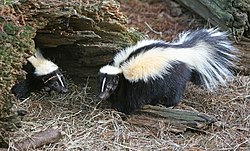
Skunk oil, also referred to as skunk grease, is an oil that is obtained from the two lateral glands that run the length of a skunk's back. Skunks store fat in these glands for use during hibernation or semi-hibernation in warmer climates. Skunk oil has minimal odor.[1]
Uses
The striped skunk is known for its defensive secretion it uses to repel predators.[2] Skunk oil has been the subject of research due to its "paradoxical nature" of being both a deterrent to potential predators and attractant to certain carnivores, such as the coyote.[3]Skunk oil was used by the Native Americans as a healing balm or liniment. Natives of the Micmac tribe of Nova Scotia, Canada, reportedly mixed skunk oil with oil from the red squirrel to produce an ingestible concoction that induced vomiting and relieved whooping cough.[4]
When rendered from the glands over a low heat, it has the consistency of an SAE10 motor oil and the feel of coal oil when applied to the skin. It gives a warming sensation as a mild liniment would.
Skunk oil was, according to later recounts, a not uncommon remedy used by frontiersmen in parts of the northern USA in the late 19th century. It was used against severe colds by rubbing it on the chest in combination with the ingestion of warm herbal teas.[5]
The early explorers and fur buyers, especially in Canada, found that the oil was a very useful addition to their medical kits and paid the natives a premium price for it.
It is also used in the United States as a way for deer hunters to mask their human odor while hunting.
Production
This section needs to be updated. (October 2021) |
In the late 19th century and early 20th century, some self-sufficient farmers in North America would produce skunk oil as a home remedy. One way to produce skunk oil was to boil the fat of several skunks and add a couple of tablespoons of male skunk glandular secretion before the oil coagulated. The oil, once cooled, could be stored in a jar for years.[6]
Around 1900, the state of Maine produced about 25,000 gallons of the oil annually which sold for about $4/gallon.[7][8]
See also
References
- ^ Archer, Britt. "What is Skunk Oil?". wise-geek.com. Wisegeek. Archived from the original on 10 October 2021. Retrieved 10 October 2021.
- ^ Wood, William F. (1999-04-01). "The History of Skunk Defensive Secretion Research". The Chemical Educator. 4 (2): 44–50. doi:10.1007/s00897990286a. ISSN 1430-4171.
- ^ Schiefelbein, Holly; Stankowich, Theodore (2016). "Aversive or Attractive? The Effects of Skunk Oil on Predator Behavior". Proceedings of the Vertebrate Pest Conference. 27 (27). doi:10.5070/V427110648. ISSN 0507-6773.
- ^ Wallis, Wilson D. (1922). "Medicines Used by the Micmac Indians". American Anthropologist. 24 (1): 24–30. ISSN 0002-7294.
- ^ Davis, LeRoy G. (1938). "Frontier Home Remedies and Sanitation". Minnesota History. 19 (4): 369–376. ISSN 0026-5497.
- ^ "Skunk Grease Medicine". Wisconsin Historical Society. 2013-04-23. Retrieved 2024-05-19.
- ^ Fur Trade Review. Vol. 25. 1897. p. 517. ISBN 978-1247969480.
- ^ Fox, Irving P. (1905). The Spatula. Vol. 12. p. 32. ISBN 978-1130517866.








